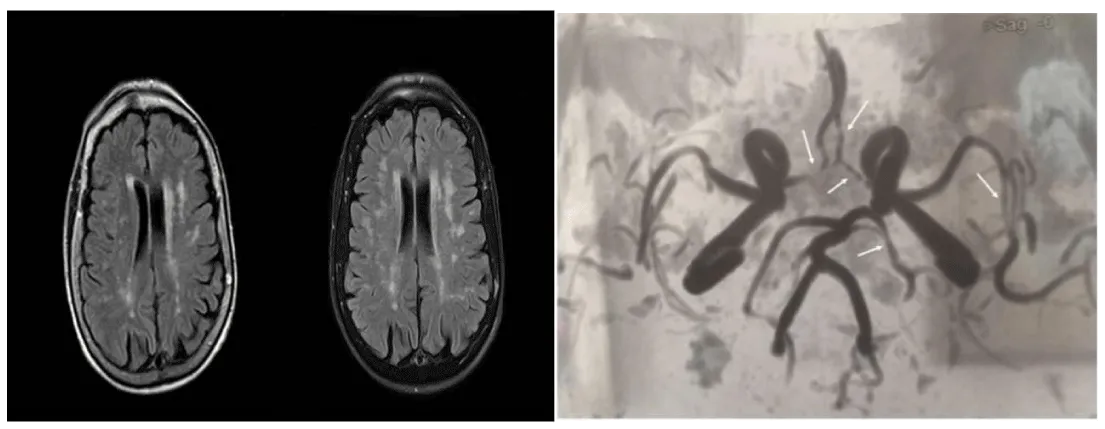Journal of Neurology, Neurological Science and Disorders
A Case of Isolated Central Nervous System Vasculitis in an Elderly Patient
Clara Bartolaminelli1, Gian Paolo Anzola2*, Matteo Filippini3 and Gianluca Boari4
2Emergency Department Spedali Civili, Montichiari, Brescia, Italy
3Rheumatology and Immunology Department Spedali Civili Brescia, Italy
4Internal Medicine Spedali Civili Montichiari, Italy
Cite this as
Bartolaminelli C, Anzola GP, Filippini M, Boari G (2017) A Case of Isolated Central Nervous System Vasculitis in an Elderly Patient. J Neurol Neurol Sci Disord 3(1): 023-024. DOI: 10.17352/jnnsd.000015Introduction
A 83 year old Italian woman, with unremarkable family history, was admitted in 2013 to a Neurology Ward for lumbar pain and progressive motor impairment of right lower limb. The only remarkable event in her past history had been a clinical diagnosis of Rheumatoid Arthritis (RA) 20 years earlier, not confirmed by laboratory tests and radiological imaging. The neurological examination showed an isolated mild right lower limb paresis, 4/5 on the MRC scale (medical research council muscle scale), no sensory deficit and preserved symmetrical tendon reflexes.
Brain MRI (magnetic resonance imaging) showed multiple patchy lesions, hyperintense on T2 and FLAIR, in the subcortical white matter and in the pons. CSF (cerebrospinal fluid) examination showed no abnormality and oligoclonal bands were absent. MRI of the spinal cord showed enlargement from D6 to D11. The ventral aspect was diffusely hyperintense on D2, with a nonhomogeneous enhancement. A transverse myelitis was hypothesized.
She was treated with intravenous pulse methyl prednisolone 500 mg for 5 days with prompt improvement; therafter steroids were switched to oral administration and dosage was tapered to a maintenance dose of 10 mg/day. The patient was stable in the following 30 months, whereby treatment was stopped. Two months after treatment cessation, a relapse occurred with reduction of lower limb strength and progressively slurred speech.
We decided to admit the patient to a Medicine Ward. A Cerebral MRI was performed, that showed multiple spot-like areas of leukoaraiosis. The patient was put on aspirin and anti-hypertensive therapy and a visit on outpatient clinic was scheduled 10 days later. At the follow up examination, the patient had no fever, blood pressure and heart rate were normal, chest examination did not show any alteration. No hepatosplenomegaly, lymphadenopathy nor peripheral edema were detected. A mild right lower limb paresis (4/5 MRC) was still present, but the patient referred a worsening. Gait was a little unsteady but patient didn’t need aid. Mild slurred dysarthric speech was present. No other neurological alteration was detected. No skin lesion was observed neither oral or genital ulcers. There were moderate deformities, without sinovitis, at the metacarpo-phalangeal, proximal and distal interphalangeal joints of both hands (osteoarthritis).
We decided to re-admit the patient. Abdominal aorta, carotid and vertebral duplex sonography did not show significant atherosclerotic disease. Echocardiography and Holter ECG (electrocardiogram) were normal. All laboratory blood tests, including C reactive protein, serum virology (HBV, HCV), retroviral tests, Lyme serology, ANA (antinuclear antibody test), ENA (extractable nuclear antigen antibody), ANCA (anti-neutrophil cytoplasmic antibodies), RA (rheumatoid factor), ACPA (anti-citrullinated peptide antibody) and antiphospholipid screening were normal. Cerebrospinal fluid showed normal protein, glucose and cell count, but 4 oligoclonal bands were detected.
Significant stenoses of medium-small cerebral vessels of both anterior and posterior circulation were detected with magnetic resonance angiography (MRA), thus suggesting the diagnosis of primary angiitis of central nervous system (PACNS). We considered the alternative diagnosis of brain angiitis secondary to systemic disease but we discarded it as the patient had no signs of systemic inflammatory disease and hand X-ray was not compatible with RA.
We treated the patient with prednisone 50 mg/day with rapid clinical and subjective improvement. After one month we reduced prednisone to 25 mg/day. In a few days, the patient reported ageusia, fatigue, and depression. A new MRI showed a progression in number and size of white matter lesions (Figure 1).
Prednisone was increased again to 50 mg/day and mycophenolate mofetil 2 g/day was added.
Three months later the patient is stable.
The absence of family history, associated abnormalities, clinical, serological, CSF and neuroradiological patterns and strong sensitivity to steroid treatment suggest the presence of a PACNS (Primary Angiitis of the Central Nervous System), at least according to the criteria proposed by Calabrese and Mallek [1]. Admittedly, the diagnosis is only presumptive in the absence of meningeal biopsy and intra arterial angiography which was deemed unsuitable. Moreover, we were not able to document the typical swelling and contrast enhancement of the vessel wall as the MR device was of insufficient power.
In the present case, the quite uncommon spinal presentation was the trigger raising the suspicion of inflammatory nature of the disease; otherwise, the cerebral MRI confluent white matter hyperintensities would have been probably interpreted as resulting from small vessel disease of atherosclerotic nature and the patient wouldn’t have been treated.
Compared with findings reported by Salvarani et al. [2], the present case shows some atypical features such as late onset, the spinal site of first clinical presentation and the rather benign course, all of which, however had been described in large series. A rather atypical presentation, therefore should not discourage a thorough diagnostic workup aimed at unmasking brain vasculitis.
In conclusion, the present case highlights that PACNS should be kept into consideration when evaluating elderly patients with diffuse white matter abnormalities of unclear origin.
- Calabrese LH, Mallek J (1988) Primary angiitis of the central nervous system: report of 8 new cases, review of the literature and proposal for diagnostic criteria. Medicine (Baltimore) 67: 20-39. Link: https://goo.gl/eUISGV
- Salvarani C, Brown Jr RD, Christianson JHT, Huston J, Giannini C, Miller DV et al. (2015) Adult primary central nervous system vasculitis treatment and course: analysis of one hundred sixty-three patients. Arthritis Rheumatol 67: 1637-1645. Link: https://goo.gl/0E2MY9
Article Alerts
Subscribe to our articles alerts and stay tuned.
 This work is licensed under a Creative Commons Attribution 4.0 International License.
This work is licensed under a Creative Commons Attribution 4.0 International License.


 Save to Mendeley
Save to Mendeley
